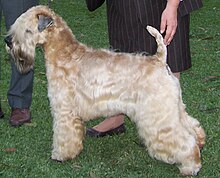Soft Coated Wheaten Terrier

Soft-coated Wheaten Terrier standing as if at a conformation dog show
|
|||||||||||||||||||||||||||
| Other names | Irish Soft-Coated Wheaten Terrier and variant spellings: "Soft Coated" and "Softcoated" |
||||||||||||||||||||||||||
|---|---|---|---|---|---|---|---|---|---|---|---|---|---|---|---|---|---|---|---|---|---|---|---|---|---|---|---|
| Common nicknames | Wheaten or Wheatie | ||||||||||||||||||||||||||
| Origin | Ireland | ||||||||||||||||||||||||||
|
|||||||||||||||||||||||||||
|
|||||||||||||||||||||||||||
| Domestic dog (Canis lupus familiaris) | |||||||||||||||||||||||||||
| Traits | |||
|---|---|---|---|
| Weight | Male | 14–20 kg (31–44 lb) | |
| Height | Male | 45 to 50 cm (18 to 20 inches) | |
| Coat | Soft and silky, loosely waved or curly | ||
| Color | Wheaten or rust color | ||
| Litter size | up to 8 | ||
| Life span | 10.7 to 12.5 years | ||
| Classification / standards | |||
|---|---|---|---|
| FCI | Group 3, Section 1 Large/medium-sized Terriers #040 | standard | |
| AKC | Terrier | standard | |
| ANKC | Group 2 (Terriers) | standard | |
| CKC | Group 4 – Terriers | standard | |
| KC (UK) | Terrier | standard | |
| NZKC | Terrier | standard | |
| UKC | Terriers | standard | |
The Soft-coated Wheaten Terrier (Irish: An Brocaire Buí) is a pure breed terrier originating from Ireland. These dogs are hypoallergenic, and are more easily tolerated by those allergic to other breeds. Wheatens typically have one of two coat types: Irish or American. The Irish coat is considered to be the breed standard. It is generally more silky and wavy than the American coat, which is thicker and more "wooly". Wheatens are generally friendly and playful, and tend to get along well with children and other dogs.
The Wheaten was bred in Ireland for over two hundred years to be an all-purpose farm dog whose duties included herding, , and vermin hunting and killing. They share a common ancestry with the Kerry Blue Terrier and the Irish Terrier but were not owned by gentry. In Ireland, they were commonly referred to as the "Poor Man's Wolfhound." Their tails used to be docked to avoid taxes and were often kept to a specific size.
Despite its long history, the Wheaten was not recognised as a breed in Ireland by the Irish Kennel Club until 1937. In 1943, the British Kennel Club recognised the breed in the UK as well. The first Wheatens were exported to Lydia Vogel in the United States in the 1940s, but serious interest in the breed took another ten years to develop. In the 1970s, the first Wheatens were imported into Australia by Anubis Kennels. Finally, in 1973, they were recognised by the American Kennel Club. Recent importation of Irish-style dogs have improved and broadened the gene pool. Today, Wheatens compete in obedience, agility, and tracking and are occasionally used in animal-assisted therapy as well.
Puppies have dark coats of red, brown, mahogany or white. Their muzzles and ears may be black or dark brown. The reddish-brown puppy coat gradually grows out to nearly white before maturing into a wheaten-coloured coat as they get older. The adult coat may contain black, white, or darker brown "guard" hairs in addition to the lighter wheaten-coloured hair. If adults ever have skin injuries, the resulting hair growth will be the dark colour of their puppy coat before it eventually grows out to the wheat color. It may also come out to a molten chocolate colour, either white or milky coloured. The breed standards for the English, American and Irish Wheaten state a Wheaten must have a single, soft silky coat.
...
Wikipedia
